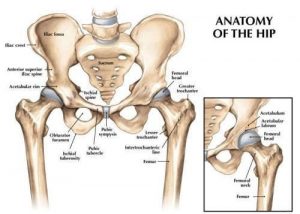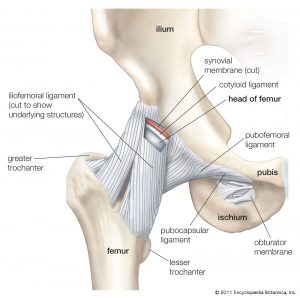I recently made a post on Facebook about the needs of individual joints in the body and a term coined by Grey Cook, “The Joint-By-Joint-Approach.”
The post got a lot traction. You can read it HERE.
I had seen a client who complained about severe back pain but after my assessment I determined his discomfort was actually coming from his hips.
He had 30º less range of motion in his left hip than his right and it was causing his low back to jam.
At the end of the session he was pain free for the first time in months.
This got me thinking about the hips, an area I truly enjoy teaching about.
LET’S TALK ABOUT ANATOMY

The hip is a ball and socket joint just like the shoulder.
Unlike the shoulder which is basically hanging in space, the head of the femur fits snugly into a hollow section of the pelvis called the acetabulum.
This allows the hip to have substantial range of motion but still less than what the shoulder has.
The head of the femur is held in the acetabulum by a thick joint capsule. (See Picture Below)

The joint capsule is basically the formation of three thick ligaments, namely the iliofemoral, pubofemoral and ischiofemoral.
- Iliofemoral ligament:
-
- Has a ‘Y’ shaped appearance and prevents hyperextension of the hip joint. It is the the strongest of the three ligaments.
-
- Pubofemoral:
-
- Has a triangular shape and prevents excessive abduction and extension
-
- Ischiofemoral:
-
- Has a spiral orientation and prevents hyperextension. It also holds the femoral head in the acetabulum.
-
MOVEMENTS AND MUSCLES
There are many movements that can be carried out by the hip joint. They are listed below along with the muscles that create those movements. As you can see, there’s a lot going on here!
- Flexion: psoas, ilicus, rectus femoris, sartorius, pectineus
- Extension: gluteus maximus, semimembranosis, semitendinosis, biceps femoris
- Abduction: gluteus medius, gluteus mimimus, piriformis, tensor fascia latae
- Adduction: adductor longus, brevis, magnus, pectineus, gracilis
- External Rotation: biceps femoris, gluteus maximus, piriformis, obdurators, gemelli brothers, quadratus femoris
- Internal Rotation: anterior fibers of gluteus medius and minimus, tensor fascia latae
- Circumduction: Everything
Since movement and awareness are the two things that matter most to me (I love anatomy but it’s not going to bring me enlightenment) let’s dive into that now.
Below is a 9 minute video designed to increase your hip mobility. Whether you have tight hips, lack of range of motion, sciatica or something else, my hope is that this will help you. Of course, if you have a more serious situation, please consult your PT or medical professional.
Yours on the path,
Jory



